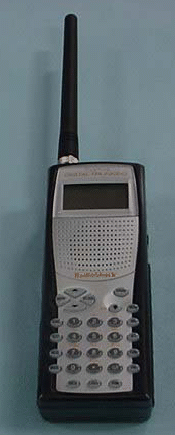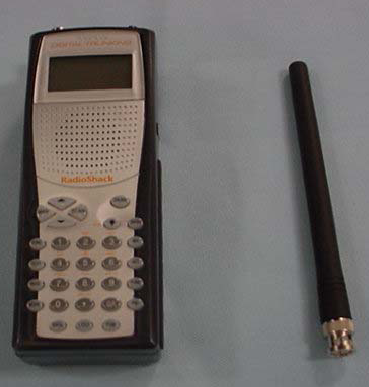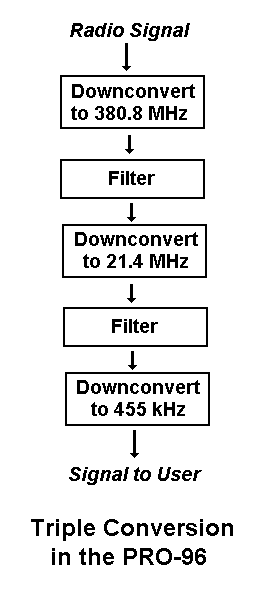| This article first appeared in the August 2003 issue of Monitoring Times. |
At the present time there are only two commercially available scanners capable of decoding APCO 25 digital transmissions, the BC250D handheld and the BC785D base/mobile, both made by Uniden. These units have been out for many months now and appear to be selling well.
However, Uniden is about to get some competition. In June Radio Shack submitted an application to the Federal Communications Commission (FCC) for a new scanner model, the PRO-96. Designed by GRE (General Research of Electronics), Inc. in Japan, the PRO-96 is a handheld scanner designed to follow both analog and digital transmissions, including APCO 25. This will be Radio Shack catalog number 20-526.
 |
 |
APCO 25 Trunking
Most notably, the PRO-96 will be able to follow the "pure" APCO 25 systems that use a 9600 baud control channel. The pre-release manual claims that the radio will automatically detect 3600 baud and APCO 9600 baud control channels and decode them accordingly. The PRO-96 will do all of this internally, without needing any external hardware or plug-in cards.
The PRO-96 will be capable of determining each of the voice ("traffic") channels for Motorola and APCO-25 systems using just the active control channel. What that means is that you will only need to program the control channels into the PRO-96, rather than every single voice frequency. Since some systems rotate the control channel on a daily basis between a handful of frequencies, each possible control channel frequency should be programmed.
A nice additional feature discussed in the manual is that when the scanner is tuned to a Motorola system control channel it will display the System Identification code and report a "decode success rate," which would give the user an indication of how well the digital signal is being received.
The manual also describes a feature called "Intelligent Adaptive Digital Tracking" which automatically tunes the sound quality settings, so the operator will not have to make any adjustments as the signal changes.
The PRO-96 will also track M/A-COM EDACS (Enhanced Digital Access Communications System) radio networks in VHF and UHF, but as with other trunking scanners, the EDACS frequencies must be entered in "Logical Channel Number" (LCN) order. The scanner does not appear to be able to follow E. F. Johnson LTR (Logic Trunked Radio) systems.
The manual claims that the scanner can track as many as 10 trunking systems at one time. Conventional and trunked systems can also be mixed in the same bank.
The PRO-96 also can be programmed with an adjustable trunking delay, anywhere from half a second to four seconds, in half-second intervals. This would allow the user to customize the amount of time the scanner would wait after the end of a transmission before resuming scanning.
Virtual Scanner
The PRO-96 introduces a new feature called "V-Scanner" (Virtual Scanner). The scanner has 11 separate configuration profiles stored in "folders," only one of which is active at a time. Each folder stores all of the operating settings, not only channels and talkgroups but lockout status, display contrast settings, and so on. Names up to 12 characters long can be assigned to each folder. Each folder has 500 channels. The idea is that you can set up a different folder for, say, each geographic location you might travel to, and by loading the correct folder your scanner is immediately able to start scanning the appropriate frequencies.
Firmware Updates
Modern scanners are controlled by internal microprocessors, tiny computers that run a single program specifically written for the scanner. The program is referred to as firmware, which is supposed to imply something between software and hardware. You can think of it as the software instructions that tell the scanner hardware what to do and when to do it.
Anyway, the important part of this is that the PRO-96 allows part of that firmware to be upgraded pretty easily. This means that if GRE comes out with fixes or enhancements to the PRO-96 after you bought it, you should be able to take advantage of it by upgrading your firmware rather than trading in your radio or swapping circuit boards.
According to the manual there are three different sections of firmware inside the radio, only one of which is capable of being upgraded. The "CPU" and "DSP Voice" sections are apparently permanent. The "DSP Application," which presumably includes the digital decoding algorithms, can be updated in the future by downloading the latest version from Radio Shack's web site (www.radioshack.com) and transferring it into the scanner via a PC-to-scanner interface cable. This should be much easier than having to replace a circuit board or a chip, as with some older scanners, or even replacing the radio altogether.
That same interface cable can be used for "data cloning," where frequencies and talkgroups can be transferred to or from another PRO-96, or to and from a computer. According to the manual, you will not be able to clone directly from another radio unless it is also a PRO-96.
Hardware

The PRO-96 is a triple-conversion receiver, meaning the desired radio signal is downconverted (translated from a higher frequency to a lower frequency) and filtered three times before being delivered to the user. This minimizes the chances of unwanted signals getting through and limits the possibility of image reception, where the scanner is tuned to one frequency but receives signals at another frequency.
On a practical level, the PRO-96 has the advantage of using regular AA batteries instead of a special battery pack like the BC250D. The PRO-96 comes with removable holders for both non-rechargeable and rechargeable batteries. The built-in charging circuit can handle nickel-cadmium (Ni-Cd) and high-capacity nickel-metal-hydride (Ni-MH) batteries.
Availability and Price
At this time the radio is expected to be available for purchase in the November timeframe with an estimated price of around $500.
|
Feature |
Uniden BC250D |
Radio Shack PRO-96 |
|
Channel Storage |
1,000 channels 10 banks of 100 |
500 channels 10 banks with 50 channels each (per folder) |
|
Additional Storage |
None |
Total of 11 virtual scanner folders, each with 500 channels (5,500 total) |
|
APCO 25 conventional |
Yes |
Yes |
|
Mixed analog and APCO 25 digital trunked (3600 baud control channel) |
Yes |
Yes |
|
"Pure" APCO 25 digital trunked (9600 baud control channel) |
No |
Yes |
|
APCO 25 Decoder |
Add-on card (BCi25D) |
Built-in |
|
Sound quality adjustment |
Manual |
Automatic |
|
Frequency loading/unloading via personal computer |
Yes |
Yes |
|
Control via personal computer |
Yes |
No |
|
Motorola Type I and II |
Yes |
Yes |
|
EDACS |
Yes |
Yes |
|
LTR |
Yes |
No |
|
Scan speed |
100 channels per second |
60 channels per second |
|
Search speed |
150 steps per second |
75 steps per second |
|
Coverage (in MHz) |
25 - 512 |
25 - 54, 108-174, 216-225, 406-512 |
|
806 - 956 (less cellular) |
806- 960 (less cellular) |
|
|
1240 - 1300 |
1240-1300 |
|
|
Proprietary battery pack |
4 standard or rechargeable AA batteries |
So, to summarize the major differences:
Pro:
Tracks 9600 baud control channel
Virtual Scanner capability
Automatic voice quality adjustment
Standard AA batteries
Firmware upgrades
Possible lower price than BC250D + BCi25D
Con:
Gaps in coverage
Fewer active channels (500) than BC250D (1000)
Doesn't track LTR systems
Possibly less sensitive than other radios in the 800 MHz band
I may be partial to GRE since my first shortwave receiver was a DX-150, but this handheld looks interesting. Most importantly, the fact that it can track 9600 baud systems will give residents of Colorado, Michigan, Minnesota, and other locations with "pure" APCO 25 systems the ability to monitor public safety and service activity where the BC250D and BC785D cannot.
Intereference
Public safety radio systems are continuing to suffer from interference. For digital radios, interference is often reported as "holes," or gaps in coverage where the radios simply do not work. Interference to analog radios can usually be heard directly, drowning out the desired voice messages. These problems are annoying at best, potentially life-threatening at worst.
Many of the reported cases of interference are related to cellular and specialized mobile radio (SMR) towers in a public safety area of coverage. As more cellular and SMR systems come on-line and their owners push for more capacity, interference problems have become more prevalent. The primary cause seems to be different design goals for each type of radio system.
Public safety radio systems are noise-limited systems, meaning their operational range and capacities are determined by the amount of radio frequency noise they can tolerate. Generally speaking, public safety radio networks need to cover a relatively large geographic area from a handful of radio tower repeater sites. The goal is to have as few sites as possible, since they're expensive to build and maintain, and have each one cover as much area as possible. In this case, broadly speaking, the more sensitive a receiver the better, since a more sensitive receiver will pick up a signal further away than a less sensitive one.
Cellular and Specialized Mobile Radio (SMR) systems, on the other hand, are interference-limited, meaning their range and capacities are determined mostly by how many other radios are operating nearby. These networks provide coverage through a large number of "cell sites" that each cover a relatively small area. The goal is to serve the greatest number of simultaneous users in the geographic region. Receivers designed for these systems, generally speaking, are better off if they have good selectivity, meaning they can exclude signals they don't want while still picking up the signals they do want.
Now, what happens when a sensitive radio designed for a noise-limited system tries to operate near a cellular system that is geared for interference-limited operation? The sensitive radio becomes desensitized, meaning it requires a stronger signal when it's near the source of interference than it would otherwise.
Public safety and cellular systems operate on different but nearby frequencies. Radio receivers are designed to reject signals that are not on the desired frequency, but they're not perfect. When a nearby signal is too close and too strong, some of that signal may leak through the receiver's filters. You may have experienced something like this when listening to the radio in your car as you drove underneath electric power lines. The "hum" you heard was radio energy (unwanted, but there nonetheless) emanating from the power lines getting past the filters in your car's radio. In general, cellular and SMR receivers, with their focus on selectivity, are often better at rejecting adjacent, unwanted signals than the public safety radios that are geared toward sensitivity.
So, what to do? As reported in this column back in February 2002, the big SMR operator Nextel floated an ambitious plan that would relocate many public safety radio systems to frequency bands that are further away from cellular and SMR signals, thus reducing the interference problem. Nextel even offered to donate $850 million to help agencies make the transition. In return, Nextel wanted additional spectrum for its own operation.
In response to the interference problems and Nextel's unsolicited plan, the FCC opened a rule-making proceeding, seeking comments and alternatives to the Nextel plan. Since then, a number of organizations joined Nextel and created a "Consensus Proposal," which subsequently underwent substantial modification. Many organizations question Nextel's motives and suspect that many cases of interference could be reduced or eliminated if Nextel did a better job filtering the transmissions from their towers.
Recently, Motorola submitted a response that included the possibility of manufacturing new public safety radios with better selectivity and other features that would help reduce the number of interference incidents. It's interesting to note that Motorola manufactures a significant amount of equipment for public safety agencies as well as SMR operators, including Nextel.
Without a clear solution in sight and lacking strong FCC action, debate over the causes and cures of public safety interference may be the only action for the foreseeable future.
That's all the space I have for this month. Look for more trunking-related information on my web site at www.signalharbor.com, and I welcome your e-mail to danveeneman@monitoringtimes.com. Until next month, happy monitoring!